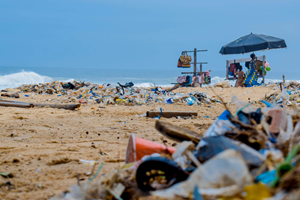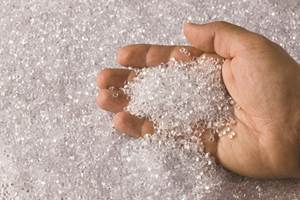PE Film Market Snap-Shot: Shrink Film
Roughly 797.3 million lb of PE was consumed making shrink film in 2017, and with growth of 1.7% forecast, consumption will hit 838.2 million lb 2020.
We’ve reported on stretch film, t-shirt bags and institutional can liners in previous installments of this blog series, which provides snap shots of the results of 2017 research conducted by market-research firm Mastio & Co., St. Joseph, Mo. on the PE film industry. Here, we recap Mastio’s research on shrink film.
Shrink film derives its name from the ability to shrink or draw down once reheated near the melting point. Shrink films are utilized in a great number of applications including the unitizing of consumer products. Some consumer products typically unitized include the following: multi-packs of hand soap, detergents, beverages (in metal, glass, and plastic containers), and health and beauty aids.
Shrink films are additionally used as case and tray overwrap to protect products during transportation and storage and are typically removed before the products are placed on store shelves. Shrink films are commonly utilized in applications formerly served by paper or corrugated cartons. In addition to PE, shrink films are also produced with from PVC and PP, specifically via the BOPP process.
The use of shrink film for unitization of consumer products is the area of largest demand, with new applications for shrink film constantly being developed, reports Mastio. Consumer appreciation of the convenience and cost savings of purchasing products in bulk has spurred the popularity in demand. Also, the continued popularity of superstores, warehouse stores, and wholesale clubs has contributed to bulk bundled products being offered to the public.
The physical characteristics required of shrink film include strength, puncture resistance, sealability, clarity, and excellent load retention. Some shrink film applications require coloring, ultraviolet light inhibitors (UVI), corrosion inhibitors, venting, varying coefficient of friction (COF) levels, anti-static additives, moisture barriers, printability, hot-tack strength, and controllable shrink or drawdown percentages.
Mastio’s research notes that shrink films are increasingly being designed for specific end-use applications, such as packaging of consumer products that require high clarity packaging to increase product visibility. With high levels of product competition and limited shelf space, products have only a few seconds to capture the attention of the consumer. Shrink films, with a haze value of 2-5%, are utilized for packaging automotive parts, books, confectioneries, games, housewares, magazines, pharmaceuticals, toys, and many other consumer products. Minimization of bulky outer packaging and source reduction of discarded packaging are additional advantages of shrink film over other means of product unitization, such as corrugated paperboard.
According to Mastio, approximately 797.3 million lb of PE was consumed last year to produce shrink film. With an average annual growth rate (AAGR) of 1.7%, Mastio projects PE consumption to produce shrink film is expected to reach 838.2 million lb 2020.
During 2017, Mastio reports that the top six producers of shrink film were Berry Global Group Inc.; Sigma Plastics Group; Bemis Co., Inc. (Bemis North America Div.); Sealed Air Corp. (Cryovac Div.); Cove Point Portfolio Holdings (Clysar, L.L.C. Div.); and Poly-America, L.P. Collectively, these companies processed approximately 500.8 million lb (62.8%) of PE resin for this market.
MATERIAL TRENDS
LDPE remains the principal material of choice to produce shrink film due to the resin’s high clarity and ease of processing, according to Mastio. LDPE-homopolymer and LDPE-EVA copolymer resin grades are extruded separately, blended, or coextruded with other polyolefins for shrink film production. LDPE-EVA copolymers are often used to increase the shrink film’s clarity, low temperature flexibility, impact resistance and heat-seal properties. LDPE-EVA copolymer resin is well suited for shrink film and bags that require printing or freezing. LDPE-EVA copolymer resin also provides excellent adhesion when used as a bond layer in coextrusion or lamination with other heat-sensitive substrates such as BOPP film, because the film surface softens as the EVA copolymer content increases. Additionally, a small amount of LDPE-acrylic acid copolymer (LDPE-EAA) was also reported.
TECHNOLOGY TRENDS
Some standard practices that are utilized in the shrink film market include continued downgauging of films with the use of multi-layer coextrusion constructions, Mastio states. Greater use of mLLDPE resin has enabled film processors to manufacture films in thinner gauges, while maintaining or even increasing film strength.
During 2017, both blown film and cast film extrusion processes were reported in the production of shrink film. The blown film extrusion process is the preferred method (with a market share above 88%), because it allows processors to custom design film with the required percent of contraction. Control of contraction and orientation in both the MD and the TD is possible using the blown film extrusion process. The amount of orientation and the resulting contraction force is accomplished by controlling extrusion variables such as the extruder output rate, melt temperature, haul-off rate, blow-up ratio (BUR), and freeze-line distance. The molecular orientation in the MD is the result of shearing force of the extruder die and the stretching action of the haul-off rollers while the film is still molten. Molecular orientation in the TD results from the blowing process that increases the diameter of the tubular film bubble. The BUR is defined as the diameter of the extruded tube divided by the diameter of the extruder die.
The cast film extrusion process allows greater control of shrink film gauge uniformity, increased clarity, and higher output rates than the blown film extrusion process. Another benefit of cast film extrusion is the ability to produce shrink films with less shrink force in the TD, since most of the potential shrink force is limited to the MD. Shrink films produced with the cast film extrusion process are often called “low force” shrink films and are used for applications such as magazine overwrap. Over contraction of shrink films in those types of applications can cause the magazines to wrap or buckle when the outer packaging is heat shrunk.
The use of multi-layer, coextruded film construction affords many benefits over monolayer film. This includes the ability to further downgauge and to construct films with different levels of COF on the inside and outside layers of the film. Coextruded shrink film ranges from two layers to seven layers, with three-layer structures being most typical. Some producers of shrink film coextrude PE resins with polypropylene (PP) resin in either two or three-layer constructions, such as PP/PE (AB configuration) or PP/PE/PP (ABA configuration).
Other reported coextruded structures include low density PE (LDPE) and LLDPE in three-layer constructions (LDPE/LLDPE/LDPE [ABA]), and PP resin with LDPE-ethylene vinyl acetate copolymer (LDPE-EVA copolymer) resin in a PP/LDPE-EVA copolymer/PP resin configuration.
MY TWO CENTS
The trend toward downgauging will continue, and that impacts consumption of PE on a per-pound basis. As is the case with many plastics markets, growth is contingent on the economy. Processors in the business are distinguishing themselves more on the basis of customer service and lead times.
Related Content
Fungi Makes Meal of Polypropylene
University of Sydney researchers identify two strains of fungi that can biodegrade hard to recycle plastics like PP.
Read MoreFundamentals of Polyethylene – Part 3: Field Failures
Polyethylene parts can fail when an inappropriate density is selected. Let’s look at some examples and examine what happened and why.
Read MoreThe Fundamentals of Polyethylene – Part 1: The Basics
You would think we’d know all there is to know about a material that was commercialized 80 years ago. Not so for polyethylene. Let’s start by brushing up on the basics.
Read MoreThe Fundamentals of Polyethylene – Part 2: Density and Molecular Weight
PE properties can be adjusted either by changing the molecular weight or by altering the density. While this increases the possible combinations of properties, it also requires that the specification for the material be precise.
Read MoreRead Next
Lead the Conversation, Change the Conversation
Coverage of single-use plastics can be both misleading and demoralizing. Here are 10 tips for changing the perception of the plastics industry at your company and in your community.
Read MorePeople 4.0 – How to Get Buy-In from Your Staff for Industry 4.0 Systems
Implementing a production monitoring system as the foundation of a ‘smart factory’ is about integrating people with new technology as much as it is about integrating machines and computers. Here are tips from a company that has gone through the process.
Read More





























